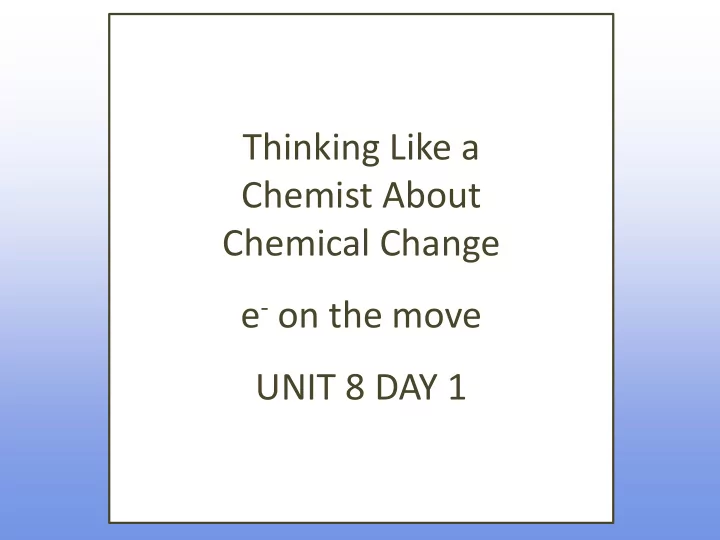

Thinking Like a Chemist About Chemical Change e - on the move UNIT 8 DAY 1
What are we going to learn today? Oxidation – Reduction Chemistry Introduction (Redox Chemistry) Tracking the movement of electrons
Macroscopic Look Chemical Change Silver/Copper Ions and Copper/ Silver Ions
Poll: Clicker Question Microscopic Thought Chemical Change The electrons are lower in energy in: A) The Silver Metal B)The Copper Metal C)They are the Same
Macroscopic Look Chemical Change Aluminum/Copper Ions and Copper/Aluminum Ions
Poll: Clicker Question Microscopic Thought Chemical Change The electrons are lower in energy in: A) The Aluminum Metal B)The Copper Metal C)They are the Same
Poll: Clicker Question Model movement of electrons Ag + (aq) + Cu(s) Ag(s) + Cu 2+ (aq) The electrons are moving from where to where? Is this reaction balanced? A) YES B) NO
Poll: Clicker Question Model movement of electrons Al + Cu 2+ Cu(s) + Al 3+ (aq) The electrons are moving from where to where? Is this reaction balanced? A) YES B) NO
Poll: Clicker Question When will these reactions stop? Ag + (aq) + Cu(s) Ag(s) + Cu 2+ (aq) Al + Cu 2+ Cu(s) + Al 3+ (aq) A) When the ion concentration goes to 0 B) When the metal disappears C) When the systems come to equilibrium D) It depends on the concentration of ions
What is the equilibrium constant?
Could you have predicted which of the reactions favor reactants and which favor products? What about one that we didn’t do… silver + aluminum ion?
Poll: Clicker Question Consider a mixture which contains Cu 2+ ions, Cu metal, Zn 2+ ions, and Zn metal. Cu 2+ (aq) + Zn ↔ Cu(s) +Zn 2+ (aq) Which side of the reaction is favored? A) Left B) Right
Poll: Clicker Question Consider a mixture of Cu 2+ ions/Cu metal and Zn 2+ ions/Zn metal. Cu 2+ (aq) + Zn ↔ Cu(s) +Zn 2+ (aq) Which will form solid metal from ions? A) Cu B) Zn
Poll: Clicker Question How many electrons are moving in this reaction? 2Al + 3Cu 2+ 3Cu(s) + 2Al 3+ (aq) A) 0 B) 2 C) 3 D) 6
Free energy of 2Al +3Cu 2+ 3Cu + 2Al 3+ e - Al 3+ Cu Cu 2+ Al We can make use of the electrons moving between reactants if you can physically separate the reactants.
To make a battery or a fuel cell, you need the electrons to flow “externally”. Al Cu 2+ Al 3+ Cu
Sometimes it is EASY to make ½ reactions Use a model to show the separation of the redox reaction: Al (s) + Cu 2+ (aq) Cu(s) + Al 3+ (aq) That is, write the oxidation ½ reaction and the reduction ½ reaction OXIDATION IS WHEN ATOM LOSES ELECTRONS: REDUCTION IS WHEN ATOM GAINS ELECTRONS:
Learning Outcomes Identify an oxidation – reduction (redox) reaction based on changes in oxidation numbers across the chemical change. Identify oxidizing/reducing agents in chemical reaction. Balance a net redox reaction using the ½ reaction method in acidic or basic solution. Recognize degrees of reactivity based on an activity series table or a standard reduction potential table. Apply standard reduction potential data to determine the relative strength of oxidizing/reducing agents
IMPORTANT INFORMATION HW 11
Recommend
More recommend